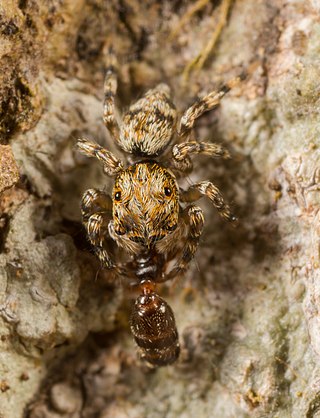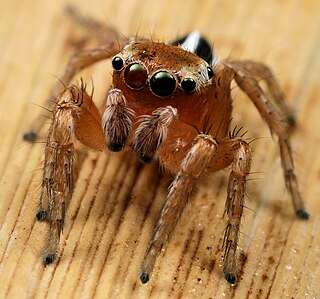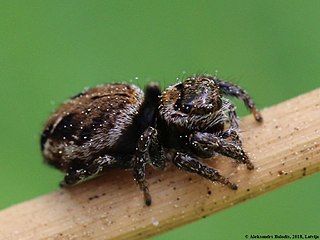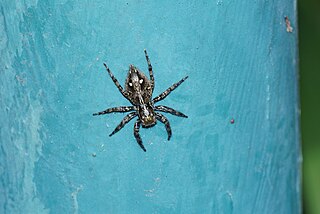
Ground spiders comprise Gnaphosidae, the seventh largest spider family with over 2,000 described species in over 100 genera distributed worldwide. There are 105 species known to central Europe, and common genera include Gnaphosa, Drassodes, Micaria, Cesonia, Zelotes and many others. They are closely related to Clubionidae. At present, no ground spiders are known to be seriously venomous to humans.

Afraflacilla is a genus of the spider family Salticidae. Most species are distributed in Eastern to Northern Africa and Australia, with two species found in Europe. This genus was for a time included in the genus Pseudicius, and the boundaries between both genera are disputed. In 2016 Jerzy Prószyński erected the genus Psenuc for some borderline species. The name Afraflacilla is combined from Africa, where most earlier described species were found, and FlacillaSimon, 1901, an obsolete salticid genus now called FlacillulaStrand, 1932. This genus name is in turn derived from Aelia Flaccilla, wife of Roman Emperor Theodosius I. Afraflacilla, Pseudicius, Festucula and Marchena are close relatives and form a monophyletic group.

Habrocestum is a genus of jumping spiders first described in 1876. They mostly occur in Eurasia and Africa, though one species has been found in Australia and another on the Solomon Islands.

Heliophanus is a genus of the spider family Salticidae. Most of the almost 170 described species occur in Africa, with many others found in the Palearctic region from Europe to Japan.

Pseudicius is a genus of the jumping spiders first described by Eugène Simon in 1885. The name is combined of Greek pseudo "false" and the salticid genus name Icius. The small genus Wesolowskana should possibly be included in this genus. There is some dispute whether Afraflacilla is a distinct genus or should be included in Pseudicius. Festucula and Marchena are other close relatives, these genera form a monophyletic group.

Zelotes is a genus of ground spiders that was first described by J. Gistel in 1848.

Harpactea is a genus of woodlouse hunting spiders that was first described by W. S. Bristowe in 1939. They are non-web building predators that forage on the ground and on tree trunks at night, mainly in xerothermic forests. During the day, they hide in silk retreats they build under rocks or bark.

Trachelidae is a family of araneomorph spiders first described by Eugène Simon in 1897 as a subfamily called "Tracheleae". The Trachelidae family, also known as "ground sac spiders", is within the group of spiders known as the RTA clade, which includes mostly wandering spiders that do not use webs. Spiders in the Trachelidae family are characterized as being 3-10mm long and having a red cephalothorax and a yellow/tan abdomen. They are commonly found indoors. It was placed in the family Clubionidae, then later in Corinnidae when the Clubionidae were split up. The first study that suggested Trachelidae should be considered its own family was done by Deeleman-reinhold in 2001 as part of an analysis of RTA Clade spiders. An analysis by Martín J. Ramírez in 2014 suggested that it was not closely related to other members of the Corinnidae, and was better treated as a separate family. It was then placed in the CTC clade of spiders, or the Claw Tuft Clasper clade, which is a group of spiders that have two tarsal claws with tufts of hair.

Wanda Wesołowska is a Polish zoologist known for her work with jumping spiders. She has described more species of jumping spider than any contemporary writer, and is second only to Eugène Simon in the history of arachnology. Originally a student of ornithology, she developed an interest in jumping spiders while still a student at the Siedlce University of Natural Sciences and Humanities in the 1970s.

Evarcha flagellaris is a species of jumping spider in the genus Evarcha that lives in Kenya and South Africa. The species was first described in 2011 by Charles Haddad and Wanda Wesołowska. The spider is small, with a carapace measuring between 2.0 and 2.4 mm long and an abdomen between 1.9 and 3.6 mm long. The female is larger than the male, particularly in the size of its abdomen. Both have stripes on the abdomen, the male being more distinct with four brown stripes contrasting with a yellow background. This is similar to the related Evarcha striolata, from which it can be distinguished by the presence of an orange scutum. It can also be identified by its copulatory organs. The female has very wide looping insemination ducts that lead to heavily sclerotized multi-chambered spermathecae. The male has a long straight projection from its tibia or tibial apophysis and a whip-like embolus. It is after the latter feature that it is named.

Evarcha acuta is a species of jumping spider in the genus Evarcha that lives in Namibia, Seychelles and South Africa. The species was first described in 2006 by Wanda Wesołowska. The spider is small, with a carapace measuring typically 1.6 mm (0.06 in) long and an abdomen between 1.4 and 1.9 mm long. The carapace is light brown with a short black eye field. The abdomen has patterns that vary depending on geography. The holotype, found near Brandberg Mountain in Namibia, has lines of brown patches on the top. Examples found in Free State, South Africa, have black lines on the top and sides. The spider can be most easily distinguished from other spiders in the genus by its copulatory organs. The male has a distinctive notch on a long straight projection from its tibia known as a tibial apophysis and a long embolus. The female has not been described.

Evarcha mirabilis is a species of jumping spider in the genus Evarcha that lives in South Africa. The species was first described in 2009 by Wanda Wesołowska and Charles Haddad. The spider is small, with a dark brown carapace measuring typically 1.9 mm (0.07 in) long and a russet-brown abdomen that is typically 1.7 mm (0.07 in) long. It is similar to related species in the genus, particularly Evarcha maculata and Evarcha patagiata. The spider has a yellow pattern on the top of its abdomen, its underside being a uniform yellow, while the underside of the carapace is orange. The legs individually have a pattern of yellow, black, yellow. The pedipalps are similarly yellow and black. The male can be distinguished from others in the genus by its copulatory organs, particularly the shape of the projection from its palpal tibia or tibial apophysis, which is short and sharp and connected to the tibia through a large base. The female has yet to be described.
Cryptodrassus is a genus of ground spiders that was first described by F. Miller in 1943.
Leptodrassex is a genus of ground spiders that was first described by J. Murphy in 2007.

Nomisia is a genus of ground spiders that was first described by R. de Dalmas in 1921.
Talanitoides is a monotypic genus of Asian ground spiders.

Evarcha ignea is a species of jumping spider in the genus Evarcha that lives in Nigeria, South Africa and Zimbabwe. It is ground-dwelling spider, thriving in leaf litter, but has also been observed living on the walls of houses. The species was first described in 2008 by Wanda Wesołowska and Meg Cumming, although the female was not described until the year after. The spider is small, with a rounded cephalothorax that is usually between 1.9 and 2.5 mm long and an ovoid abdomen that is between 1.6 and 2.2 mm long. The female is slightly larger than the male. It is also lighter. The male has a mostly dark brown carapace and russet-brown abdomen, while the female's carapace is whitish-yellow and abdomen creamy. The male spider's face, or clypeus, is covered in bright scarlet scale-like hairs, which gives the spider its name, which can be translated "fiery". This is similar to the related Evarcha bakorensis. To distinguish this species from others in the genus, it is necessary to compare their copulatory organs. The male Evarcha ignea has a distinctive small notch on the spike, or apophysis, that emanates from its palpal tibia. The female has shorter insemination ducts than other species, and spermathecae that have a large first chamber.

Plexippus tsholotsho is a species of jumping spider in the genus Plexippus that lives in South Africa and Zimbabwe. It was first described in 2011 by the Polish arachnologist Wanda Wesołowska. The species was first found in the Zimbabwean district of Tsholotsho, after which the species is named. Only the female has been described. It is a large spider, with a cephalothorax 4 mm (0.16 in) long and abdomen 5.2 mm (0.20 in) long. It is generally dark brown in colour, with a lighter brownish orange tint to the rear of the carapace and a white stripe along the body of the abdomen. It is distinguished from the otherwise similar Plexippus paykulli in the shape of the copulatory ducts in the epigyne and the presence of significant sclerotization around the gonopores.
Marinarozelotes is a genus of ground spiders first described by A. V. Ponomarev and V. Y. Shmatko in 2020. The type species, Marinarozelotes barbatus, was originally described under the name "Melanophora barbata".
Capobula is a genus of southern African spiders in the family Trachelidae. The type species was first described by Eugène Simon from a juvenile found in South Africa. It was placed with Orthobula for several morphological similarities, including a large sclerite beneath the abdomen and spines behind several of the legs. After a more thorough examination in 2021, including both male and female adults, enough distinctive features were found in the holotype and several other newly discovered species to warrant a new genus.














